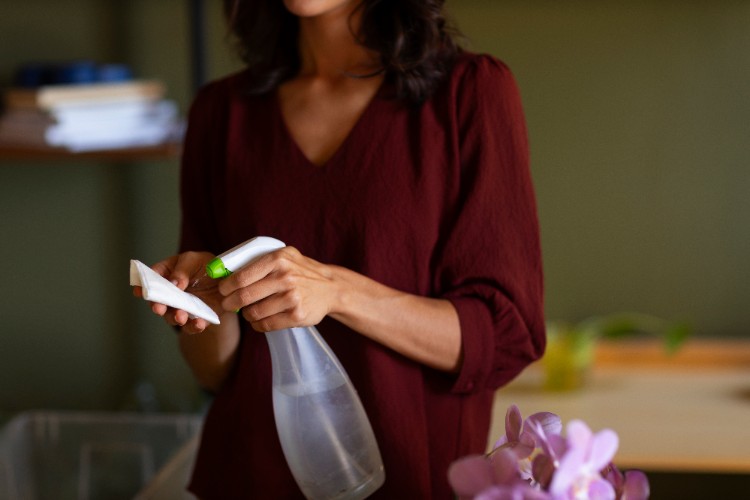Does Hypochlorous Acid Actually Disinfect?
Hypochlorous acid (HOCl) is gaining attention as a revolutionary disinfectant. But does it truly live up to the hype? Is it as effective as traditional cleaning solutions like sodium hypochlorite or hydrogen peroxide? Let’s explore the science, benefits, and real-world applications of HOCl to determine if it is the future of cleaning and disinfecting.

What is Hypochlorous Acid?
Hypochlorous acid (HOCl) is a naturally occurring molecule produced by white blood cells in the human immune system. It plays a crucial role in killing bacteria, viruses, and fungi, helping the body fight infections.
Chemically, HOCl belongs to the chlorine family and is a powerful oxidizing agent. Unlike sodium hypochlorite (commonly known as bleach), HOCl exists at a neutral pH, making it much safer for human use while retaining strong antimicrobial properties.
HOCl is created by dissolving chlorine gas in water under specific pH conditions. It is also generated using a Hypochlorous Acid Generator, which electrolyzes salt and water to produce this powerful disinfectant.
How Does HOCl Work to Kill Pathogens?
HOCl kills bacteria and viruses by breaking down their cell walls and disrupting their proteins and DNA. This mechanism, known as oxidative damage, effectively neutralizes pathogens without creating harmful residues.
Key Mechanisms of HOCl Disinfection:
· Cell Membrane Disruption – HOCl penetrates microbial cell walls and destroys them from the inside.
· Protein and DNA Breakdown – It disrupts the genetic material of bacteria and viruses, preventing replication.
· Reduction of Bacterial Load – HOCl reduces microbial presence on surfaces and in the air, making it effective for large-scale disinfection.
Scientific studies confirm that HOCl is highly effective at killing bacteria, fungi, and viruses, including E. coli, Staphylococcus aureus, and even SARS-CoV-2.
HOCl vs. Traditional Disinfectants: Which is Better?
1. HOCl vs. Sodium Hypochlorite (Bleach)
Feature | HOCl | Sodium Hypochlorite (Bleach) |
Disinfection Power | Stronger at killing bacteria | Effective but requires higher concentrations |
pH Level | Neutral pH (6-7) | Highly alkaline (pH 11-13) |
Safety | Non-irritating to skin and eyes | Can cause burns and irritation |
Environmental Impact | Biodegradable, non-toxic | Can release toxic chlorine gas |
Shelf Life | Shorter, needs fresh production | More stable but degrades over time |
HOCl is a superior option in terms of safety, effectiveness, and eco-friendliness, making it a preferred choice for many industries.
2. HOCl vs. Hydrogen Peroxide
Both HOCl and hydrogen peroxide are powerful oxidizing agents, but HOCl has distinct advantages:
· HOCl is more stable and does not decompose as quickly as hydrogen peroxide when exposed to light.
· It is less corrosive to surfaces and equipment.
· HOCl works faster at killing bacteria and viruses.
Hydrogen peroxide is still widely used in hospitals, but HOCl is gaining popularity due to its cost-effectiveness and superior antimicrobial properties.
Applications of HOCl in Disinfection
HOCl’s versatility allows it to be used in multiple industries for cleaning and disinfecting.
1. Healthcare and Wound Care
HOCl is widely used in hospitals and clinics to disinfect surfaces, medical equipment, and even wounds. Its ability to kill bacteria while being gentle on human tissue makes it ideal for wound irrigation and infection control.
Studies show that HOCl reduces bacterial load in wounds and promotes faster healing. It is commonly used in:
· Surgical wound care
· Burn treatment
· Diabetic ulcer management
2. Food Industry and Agriculture
The food industry uses HOCl to sanitize food processing equipment, storage areas, and even fresh produce. Its neutral pH and non-toxic properties make it safer than traditional chlorine-based disinfectants.
In agriculture, HOCl is used to:
· Disinfect irrigation systems
· Prevent bacterial contamination in livestock
· Extend the shelf life of produce
3. Water Treatment and Public Spaces
HOCl is used to purify drinking water and disinfect swimming pools. It kills harmful microorganisms without producing chlorine gas, which can be dangerous in enclosed spaces.
Public spaces like schools, offices, and transportation hubs use HOCl for large-scale sanitation. Its ability to kill viruses quickly makes it an essential tool during pandemics.
4. Home and Personal Use
HOCl-based disinfectant sprays are becoming popular for home cleaning, especially for kitchens, bathrooms, and baby products. Unlike harsh chemicals, HOCl is safe for children and pets.
HOCl Generators: The Future of Disinfection?
One of the biggest advantages of HOCl is that it can be produced on-site using a Hypochlorous Acid Generator. These devices use salt and water to generate fresh HOCl solutions, making disinfection cost-effective and sustainable.
Benefits of using an HOCl generator:
· No need for harmful chemical storage
· Fresh HOCl production ensures maximum potency
· Reduces plastic waste from bottled disinfectants
· Lower costs compared to purchasing chemical disinfectants
Many businesses and hospitals are now investing in HOCl generators to ensure a steady supply of this powerful oxidant.
Challenges and Limitations of HOCl
Despite its many advantages, HOCl has some challenges:
1. Shelf Life – HOCl solutions degrade over time and must be produced fresh.
2. Storage Conditions – Light and heat can break down HOCl, reducing its effectiveness.
3. Public Awareness – Many people are still unaware of HOCl’s benefits and rely on outdated disinfectants.
However, advancements in HOCl stabilization technology are helping overcome these issues, making it more accessible for everyday use.
Final Verdict: Does Hypochlorous Acid Actually Disinfect?
The answer is a resounding YES. Hypochlorous acid is a powerful, safe, and effective disinfectant with applications in healthcare, food safety, water treatment, and home cleaning. Its natural antimicrobial properties make it an ideal alternative to harsh chemicals like bleach and hydrogen peroxide.
With the growing demand for non-toxic, eco-friendly disinfectants, HOCl is poised to become the future of cleaning and sanitization.
